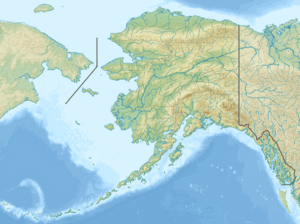Itkillik River facts for kids
Quick facts for kids Itkillik River |
|
|---|---|
|
Location of the mouth of the Itkillik River in Alaska
|
|
| Country | United States |
| State | Alaska |
| Borough | North Slope |
| Physical characteristics | |
| Main source | Endicott Mountains Near Oolah Pass, Brooks Range 5,276 ft (1,608 m) 68°05′18″N 150°00′22″W / 68.08833°N 150.00611°W |
| River mouth | Colville River 25 miles (40 km) southwest of Harrison Bay on the Beaufort Sea 7 ft (2.1 m) 70°09′00″N 150°56′20″W / 70.15000°N 150.93889°W |
| Length | 220 mi (350 km) |
The Itkillik River is a river in Alaska, a state in the United States. It is about 220 miles (350 km) long. This river flows into the Colville River, which is a much larger river.
Contents
About the Itkillik River
The Itkillik River starts in the Endicott Mountains, which are part of the Brooks Range. It flows first towards the northeast and then turns northwest. Eventually, it joins the Colville River. This meeting point is about 25 miles (40 km) southwest of Harrison Bay, which is on the Beaufort Sea.
What Its Name Means
The name Itkillik comes from the Iñupiaq people. They are the native people of this region in Alaska. Around the year 1900, an Iñupiaq map showed the river as It-kil-lik. This name means "Indian".
The Stinking Hills Mystery
Along the Itkillik River, there is a special place known as the Stinking Hills or Stinky Bluffs. This area is famous for a large formation of melting permafrost. Permafrost is ground that stays frozen all year round, even in summer.
What is Yedoma?
This particular permafrost formation is called a yedoma. Yedoma is a type of ice-rich permafrost that formed a very long time ago. The one along the Itkillik River is the biggest known yedoma in Alaska. It formed between 50,000 and 10,000 years ago.
Ancient Discoveries
Inside this huge ice cliff, which is about 100 feet (30 meters) high and 1,200 feet (370 meters) long, scientists have found amazing things. It holds the remains of ancient animals! These include:
- Bison
- Muskoxen
- Mammoths
- Other animals that lived thousands of years ago
Why It Smells
The ice in this yedoma is full of a gas called methane. When the ice melts, these gasses are released into the air. These gasses have a strong smell, which is why the area got its nickname, the Stinking Hills. It's like a natural time capsule that's slowly revealing its secrets as the ice thaws.


